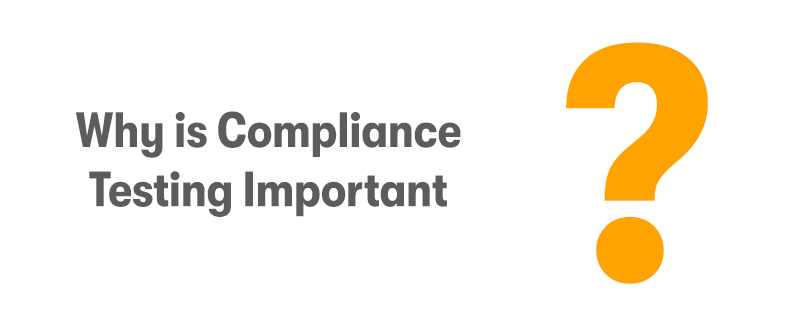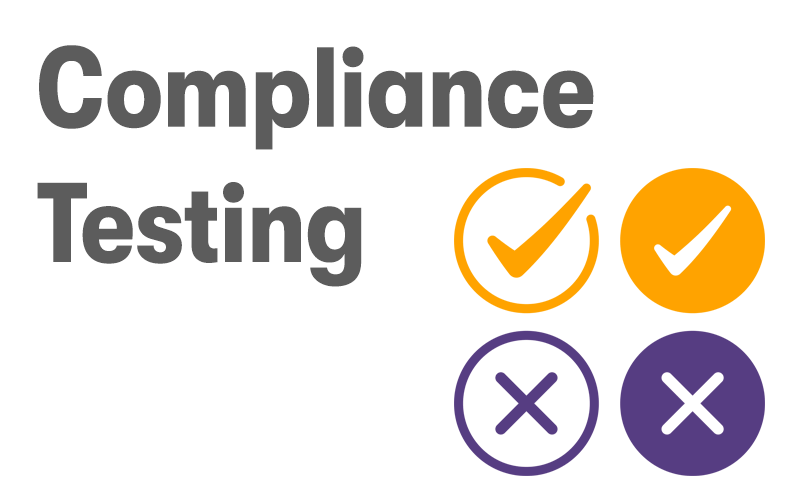Compliance Testing
Compliance testing is a linchpin for businesses aiming to navigate the complex environments of regulatory standards and consumer expectations. This strategic tool ensures that products and services align with legal, safety, and industry benchmarks.
As organisations strive to establish trust, enter new markets, and maintain a competitive edge, understanding compliance testing becomes increasingly more important.
Compliance testing can be traced back to industrial standardisation in the early 20th century. As industries evolved, so did compliance tests, adapting to new technologies and expanding globally to uphold international regulatory standards and practices.
In this blog we will discuss its importance, methodology, benefits, and inherent challenges. We have also included a step-by-step guide on conducting compliance testing.
What is Compliance Testing?

Compliance testing, also known as conformity testing, verifies whether a product, system, or process meets the specified requirements of a particular standard, regulation, or guideline.
This type of testing is critical in various industries, including but not limited to healthcare, finance, telecommunications, and manufacturing. The primary goal is to ensure that products or systems fully comply with all relevant standards and regulations before they are released to the market or used in a particular environment. The process of compliance testing can involve several steps, including:
- Identification of applicable standards and regulations.
- Review and analysis of the requirements.
- Planning and execution of testing.
- Documentation and reporting.
- Rectification and re-testing (if necessary).
Compliance testing helps to minimise legal and regulatory risks, ensures product safety and quality, and enhances customer trust and satisfaction by ensuring that products meet industry standards and regulatory requirements.
Why is Compliance Testing Important?

Compliance testing is critical for several reasons, affecting not only the organisations that develop products and services but also the end-users and society. Here are some of the key reasons why compliance testing is essential:
Regulatory Compliance and Legal Requirements
Many industries are regulated by government bodies that set forth standards and regulations to ensure products and services are safe, reliable, and fit for purpose. Compliance testing ensures these requirements are met, helping organisations avoid legal penalties, fines, and sanctions resulting from non-compliance.
Safety and Quality Assurance
Compliance testing verifies that products and systems are safe for consumers and users. This is particularly crucial in healthcare, automotive, and electronics industries, where safety is paramount. By adhering to recognised standards, organisations can ensure their products do not pose a risk to users.
Market Access and Global Trade
Many markets require products to meet specific standards and obtain certifications before selling them. Compliance testing is a necessary step to enter these markets. For companies looking to expand globally, meeting international standards through compliance testing can be essential for success in new markets.
Customer Trust and Brand Reputation
Consumers and businesses are increasingly aware of and concerned about their products' quality, safety, and environmental impact. Organisations can build customer trust and enhance their brand's reputation by ensuring compliance with relevant standards. Compliance is often seen as a mark of reliability and commitment to quality.
Competitive Advantage
Organisations that consistently meet compliance standards can distinguish themselves from competitors. Compliance can be a key differentiator in markets where consumers are concerned about product quality, safety, and ethical considerations.
Operational Efficiency and Risk Management
Compliance testing can help organisations identify potential issues and areas for improvement in their products and processes. By addressing these issues, companies can reduce the risk of product failures, recalls, and customer complaints, leading to better operational efficiency and reduced costs over time.
Environmental Protection and Sustainability
Many compliance standards focus on environmental protection, requiring products to be energy-efficient, minimise waste, or reduce the use of hazardous materials. Compliance testing ensures that products meet these sustainability standards, contributing to environmental protection efforts and meeting the growing demand for eco-friendly products.
How to Test Compliance?

Testing compliance involves a systematic process tailored to the specific standards, regulations, and industry practices applicable to the product or system. The following steps outline a general approach to conducting compliance testing:
Step 1: Identify Applicable Standards and Regulations
Research: Determine the relevant local, national, and international standards and regulations for the product or service. This may include industry-specific standards, environmental regulations, safety standards, and data protection laws.
Consultation: Engage with regulatory bodies, industry associations, or compliance experts to identify and understand all applicable requirements.
Step 2: Understand Compliance Requirements
Documentation Review: Thoroughly review the standards and regulations to understand the specific requirements for compliance. This includes technical specifications, safety guidelines, environmental impact limits, and other pertinent criteria.
Gap Analysis: Perform a gap analysis to identify areas where the product or system might not meet the required standards. This involves comparing current product specifications and practices against the compliance criteria.
Step 3: Develop a Compliance Testing Plan
Scope and Objectives: Define the scope of the testing, including the specific standards and regulations to be addressed. Outline the objectives and expected outcomes of the compliance testing process.
Testing Methods: Select appropriate testing methods and tools for each compliance requirement. This may involve laboratory testing, simulation models, software audits, or physical inspections.
Schedule and Resources: Develop a timeline for the testing process and allocate the necessary resources, including personnel, equipment, and facilities.
Step 4: Execute Compliance Testing
Conduct Tests: Carry out the planned tests according to the established procedures. This may involve both internal testing within the organisation and external testing by accredited third-party laboratories or certification bodies.
Documentation: Record all testing procedures, methodologies, and results in detail. Proper documentation is crucial for demonstrating compliance with regulatory bodies and for future reference.
Step 5: Analyse Results and Implement Changes
Review Findings: Analyse the testing results to determine whether the product or system meets the required standards. Identify any areas of non-compliance or potential improvement.
Corrective Actions: If non-compliance issues are identified, develop and implement a plan to address these issues. This may involve redesigning the product, modifying processes, or implementing new controls.
Step 6: Certification and Reporting
Certification: Some standards may require certification from an accredited body. Submit the necessary documentation and comply with any additional requirements for certification.
Compliance Reporting: Prepare and submit compliance reports detailing the compliance testing process and outcomes to the relevant regulatory bodies or stakeholders.
Step 7: Continuous Compliance and Monitoring
Monitoring: Establish ongoing monitoring procedures to ensure continued compliance with all relevant standards and regulations, significantly as they are updated or as the product or system evolves.
Training and Awareness: Keep the team informed about compliance requirements and best practices through regular training and updates.
Compliance testing can be complex and requires meticulous planning and execution. Depending on the specific standards and regulations, the process might involve specialised knowledge and expertise. Engaging with experts or consulting services specialised in compliance can be beneficial, especially for navigating complex regulatory environments or for products with novel technologies or applications.
The Advantages of Compliance Testing
Compliance testing offers several significant advantages across various dimensions of a business, product lifecycle, and customer engagement. Understanding these benefits can help organisations appreciate the value of investing in compliance testing as part of their development, production, and market entry strategies. Here are the key advantages:
Ensures Regulatory Compliance
Compliance testing verifies that products meet all required regulations and standards, helping to avoid legal penalties, fines, and sanctions associated with non-compliance. This is crucial for operating legally and ethically in regulated industries.
Enhances Product Safety and Quality
By adhering to established standards, compliance testing ensures that products are safe and of high quality. This reduces the risk of product failures, safety incidents, and recalls, which can be costly and damaging to a company's reputation.
Facilitates Market Access and Expansion
Many markets have specific compliance requirements. Successfully passing compliance testing enables products to be sold in these markets, facilitating market access and expansion. Compliance can also be a competitive advantage in markets where consumers value and prioritise safety and quality.
Builds Customer Trust and Loyalty
Products that meet compliance standards are often viewed as more reliable and trustworthy by consumers. This can enhance customer satisfaction, build brand loyalty, and encourage repeat business.
Minimises Legal and Financial Risks
Compliance testing helps identify and mitigate risks early in the product development cycle, reducing the likelihood of costly legal challenges, fines, and recall expenses. It also minimises the risk of reputational damage that can arise from non-compliance issues.
Promotes Consistency and Reliability
Adhering to industry standards promotes consistency and reliability across product lines, which is especially important for companies with diverse products or services. Consistency helps in maintaining brand integrity and customer satisfaction.
Supports Sustainability and Social Responsibility
Many compliance standards include environmental and social governance criteria. Meeting these standards demonstrates a company's commitment to sustainability and social responsibility, which can enhance its image and appeal to like-minded consumers and partners.
Drives Continuous Improvement
Preparing for and undergoing compliance testing can reveal opportunities for process and product improvements. Organisations can leverage these insights to innovate and enhance their offerings, leading to better products and services over time.
Improves Operational Efficiency
Compliance testing can optimise processes and resources, improving overall operational efficiency. It can also help streamline product development cycles by identifying potential compliance issues early, avoiding costly reworks.
Enhances Competitive Advantage
Organisations that consistently meet or exceed compliance standards can differentiate themselves in the marketplace. This can be a significant competitive advantage, attracting customers and partners who value compliance and quality.
In summary, compliance testing is not just a regulatory requirement but a strategic business investment that offers numerous advantages, including enhanced product safety, market access, customer trust, and competitive positioning. It supports long-term sustainability and success by ensuring products meet the highest standards of quality, safety, and reliability.
The Limitations of Compliance Testing

While compliance testing is crucial for ensuring that products and services meet specific standards and regulations, it has limitations and challenges. Recognising these limitations helps organisations to strategize effectively and address potential gaps in their compliance and quality assurance processes. Here are some of the notable limitations:
Cost and Resource Intensive
Compliance testing can be expensive, requiring significant time, money, and resource investment. For small and medium-sized enterprises (SMEs), the cost of testing and certification can be particularly challenging, impacting their ability to compete with larger corporations.
Dynamic Regulatory Environments
Regulations and standards are often subject to change. Keeping up with these changes can be challenging for businesses, especially those operating in multiple markets with different regulatory requirements. This dynamic environment can necessitate frequent re-testing and certification, adding to the complexity and cost.
Limited Scope
Compliance testing typically focuses on specific standards or regulations, which means it may not cover all potential issues or aspects of product quality and safety. Passing compliance tests does not guarantee that a product is flawless or will meet all users' needs and expectations.
Potential for False Sense of Security
Achieving compliance can sometimes lead to a false sense of security, where organisations might need to pay more attention to continuous improvement and innovation in product safety and quality. It's important to remember that compliance represents a minimum standard, not the pinnacle of quality.
Complexity in Global Markets
Navigating the compliance requirements of different countries can be complex. Products intended for global markets may need to undergo multiple rounds of testing to meet the specific standards of each country or region, which can be a logistical and regulatory headache.
Time-Consuming Processes
The process of preparing for, undergoing, and maintaining compliance can be time-consuming. Delays in testing or certification can impact product launch timelines and market entry strategies, potentially leading to lost opportunities.
Does Not Guarantee Market Success
While compliance facilitates market access and builds consumer trust, it does not guarantee market success. Other factors, such as product design, market positioning, and consumer preferences, also play critical roles in determining the success of a product.
Rigid Requirements May Stifle Innovation
In some cases, the stringent requirements of compliance testing can stifle innovation. Companies might focus more on meeting existing standards rather than pushing the boundaries of what is possible, potentially limiting technological advancement and creativity.
Dependence on Third Parties
Compliance testing often requires reliance on external laboratories or certification bodies. This dependence can introduce risks related to the quality and integrity of the testing process, as well as potential delays if these third parties are overloaded or operate under different standards.
Data Security and Privacy Concerns
Compliance testing can raise concerns about data security and privacy for certain products, especially those in the tech and digital sectors, especially when sensitive information must be shared with external testers or regulatory bodies.
Organisations should adopt a proactive and strategic approach to compliance to mitigate these limitations, integrating it seamlessly with broader quality assurance, risk management, and product development processes.
Additionally, staying informed about regulatory changes, leveraging technology to streamline compliance processes, and fostering a culture of continuous improvement can help overcome some of these challenges.
Final Notes on Compliance Testing
In conclusion, compliance testing ensures that products meet standards and offer quality and safety, though it brings challenges like costs and potential innovation limits. Yet, its advantages, such as safety and market edge, outweigh the drawbacks. Practical strategies and ongoing improvement are vital to leveraging compliance for success.
One final tip for compliance testing is prioritising establishing a proactive compliance culture within your organisation. Encourage continuous learning and adaptation to regulatory changes, fostering an environment where compliance is viewed as an integral part of quality and innovation, not just a checkbox.




